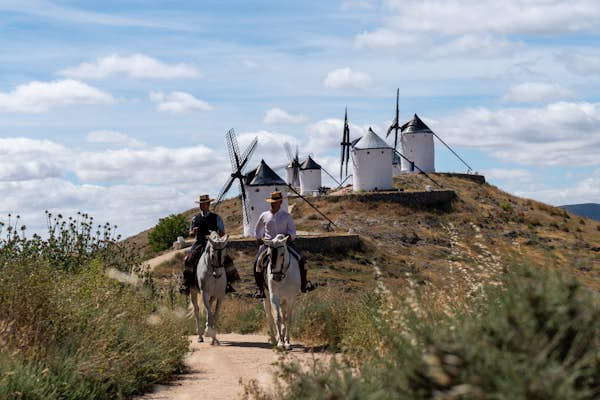

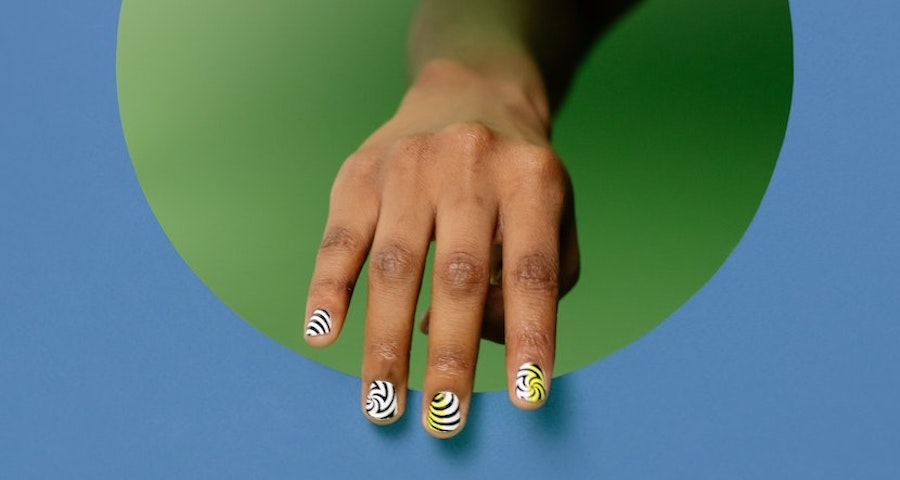
How to stop biting your nails, from a former lifelong nail biter
Here’s every tactic I’ve tried to combat this addictive habit.
There are two instinctive reactions when ‘nail-biting’ is brought up in conversation. Those with long, enviable, healthy nails who scrunch up their nose, and those with little stubs for nails who go quiet from embarrassment or shame. “Just stop doing it, it’s really not that hard! Or else you’ll never have nice, long nails,” people chastise.
Habitual nail biting is actually a really common (and annoying) habit. Its scientific term is onychophagia, and it affects 20 to 30 per cent of the global population, with 45 per cent of those nail gnawers being teenagers. It’s an addictive habit that’s often done absentmindedly, and before realising what you’re doing, most of your nails are already gone. But why do people do it?
We like nosy people. Don’t be shy, head to our Beauty section for more.
Nail biting usually starts in childhood, and while some grow out of it as they get older, for others it becomes a habitual routine. Nail biting is a well-known habit that people do when anxious or stressed, but that’s not the only time people can be found busy biting their nails. For many, it’s a comfort thing.
If people are busy concentrating, hungry, frustrated or bored, nail biting is a time occupier – an absentminded solution. Once you’re deep in the habit of nail-biting, it can be extremely hard to stop. Take it from me; I’ve been nail-biting for as long as I can remember. And in a gross, guilty-pleasure way, I kind of enjoy it. I can’t explain why, but it feels good. My fellow nail-biters will get me.
My childhood memories are full of my mum, dad, nonna and every other relative slapping at my hands and telling me to “get your fingers out of your mouth before you wreck your nails”. When I’m feeling like a nostalgia wave and look through old photo albums, I always pause on one photo of myself: I’m probably three years old, sitting in our rocking chair, busy biting my pointer nail.
At school, my friends would tease me about my short nails, waving their long, healthy nails in front of my face. As much as I wanted my nail beds to look like theirs, this was an unattainable wish for me. It’s not like I wanted to do it, but I simply couldn’t help it. Nail biting is a hard habit to break.
My whole life, I’ve had tiny nails that make me cringe when I scroll through my camera roll. Attempting to make them look prettier by painting them only turned them into colourful stubs. Over the years, every effort I’ve made to stop biting them has failed. Truly, I’ve tried everything.
Until now. I’ve finally cracked the code to break the nail-biting habit. And the remedy? It’s way simpler (and cheaper) than you think.
So, I’m going to run you through every tactic I’ve tried to combat this addictive habit, why they didn’t work, what not to waste your money on and what’s working for me now.
Bitter-tasting nail polish
I attempted this method when I was 11 or 12, and my mum was fed up with my nail-biting-antics (which is so fair, I was too). Lathering your nails in a polish that tastes so foul, it forces you to lay off attacking them? It sounds foolproof. Unfortunately, that didn’t stop me.
Within a week of wearing the polish, I was working my way around it. I developed a technique where I peeled off the polish with my fingers, and when that didn’t work, I used my teeth (hoping the polish wouldn’t touch my tongue, of course). Gross, I know.
I’m sure this tactic would work for many people, otherwise this stuff wouldn’t be around. Maybe if I tried it again when I was older, it would work, but I haven’t bothered since (also I’m just trying to make myself feel better, tbh).
Positive reinforcement
This method is all about willpower, and unfortunately, I couldn’t muster enough. When I attempted this, I would conjure up rewards for not biting my nails for a certain period of time. So, if I went a week without biting my nails, I’d finally buy that top I had my eye on for months.
Halfway through the challenge, I’d cave. Feeling down and sorry for myself, I’d end up buying the thing I wanted despite not completing the challenge. I’d justify it by reasoning with myself, saying ‘I’ve had a hard week, I deserve this’.
SNS nails
I don’t know where the myth of ‘SNS nails make your natural nails stronger’ came from, but I lapped it up the second I heard it. Sure, your nails are sturdy and strong while the SNS is on, but the second you soak off the manicure, that added security is gone.
I thought SNS would be a great way to break the habit of biting my natural nails. I set off to the nail salon to get my manicure, thinking I’d be able to break the habit of biting my nails while the tips were on, so that when I soaked them off I wouldn’t be tempted to bite my nails.
I tried this for years, and it never worked. While I enjoyed having long, gorgeous nails for a few short weeks, it didn’t transfer to my natural nails. When the tips came off, my nails weren’t stronger like the rumour had promised. Instead, they were even weaker than before. Left brittle and paper thin, the small regrowth my nails saw broke off within a few days – if I hadn’t bitten them off first.
I tried cutting my nails after the SNS, so I could allow them to regrow stronger and healthier, but this also did nothing. The short length simply reaffirmed my subconscious habit, so once the nails were cut, they never grew long again.
After trying all these methods to no avail, I felt pretty hopeless. Until I finally found the one solution that has successfully worked for me.
Keeping a tally
Yes, you read that correctly. This is the only way I have been able to stop biting my nails for a long period of time, and I think the habit has finally been broken. As of today, I have triumphantly not bitten my nails for 10 weeks.
In my notes app, I’ve started a tally wherein each day withstanding the urge to nail bite, I add a line. If I fail, I must go back, delete the entire tally, and start over. And the good thing? I haven’t had to spend a dollar on any products that run the risk of failing me.
This tactic plays into my pride, stubbornness and perfectionism. The thought of shamefully deleting my tally after an anxious nail-biting session is really embarrassing, even though I’m the only one who sees it.
Every nail biter is as unique as their nail beds, so one of the tactics that didn’t work for me may work for you (which is great!). But tallying has been my way forward out of this lifelong habit, and if you’re looking for an out, I recommend giving this a go.
This article was originally published on October 5, 2022.
For more on how to stop biting your nails, try this.
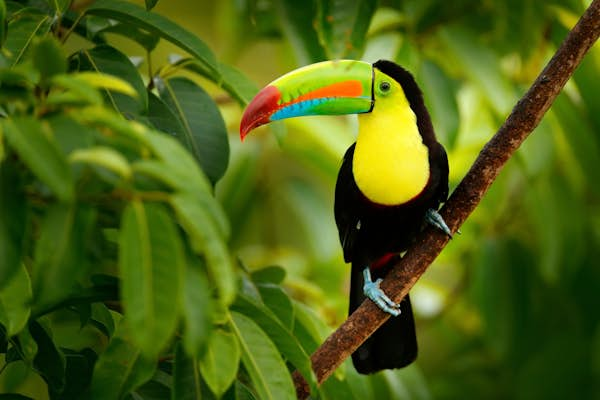
The 7 best places to see wildlife in Central America
Imagine a land that accounts for just 1% of the Earth’s surface but over 8% of its total biodiversity – somewhere that crosses biomes as varied as wave-lashed beaches and humid cloud forests. That’s Central America in a nutshell, a place where you can glimpse gigantic whales in the Pacific, spy stalking jaguars in the jungles and swim coral reefs in the Caribbean.
Recent years have seen the region enter the frontline of global conservation. There are some serious challenges ongoing, not least of all deforestation and habitat destruction in the face of climate change. But there has also been a big drive to establish contiguous nature reserves that foster and rebuild ecosystems that support the menagerie of species that make their home here.
This list of the best places to see wildlife in Central America touches on just a few of the highlights, from Costa Rica’s sloth-filled coast to the impenetrable Panamanian sierras.
Parque Nacional Darién in Panama
Best for wilderness vibes
This is a wild, wild land – just a mention of the name Darien is usually enough to conjure images of impenetrable rainforest. You’re looking at 5,790 sq km of land in Panama, touching the Pacific at one end and the Serrania del Darien mountains on the Colombian border at the other. No road goes through it, and the only real towns are abandoned colonial-era mining settlements.
The best area for wildlife viewing is around the long-out-of-use ranger station under Cerro Pirre. A couple of trails lead out from there into the densest parts of the jungle. There are regular reports of mantled howler monkeys, sloths, Baird’s tapirs and even jaguars – beyond that, nobody really knows. Pack accordingly, as this is the frontier.

Monteverde Cloud Forest Reserve in Costa Rica
Best for bird-watchers
Monteverde is a magnet for wildlife lovers. This gem in Puntarenas province is famed for its lush cloud forest habitats that exist on the tips of the Cordillera de Tilaran between 4,600 and 5,900ft. It covers more ecological zones than you could count on one hand and consists of 90% primeval rainforest. Some stats, huh?
The flora and fauna, as you’d expect, is also pretty darn startling. The birds run the gamut from the teal-plumed resplendent quetzal to the brazenly bold violet sabrewing hummingbird, and big mammals include white-faced capuchins and elusive ocelots. The plants range from vivid bromeliads to the biggest ferns you’ll ever see.
All of that’s fantastically knitted together by a series of well-marked trails that sometimes cross soaring canopy bridges suspended over the woods. Binoculars are a must for peering through the vegetation at birds and whomever else you manage to spot; so are waterproofs, as cloud forests are famously wet. Generally speaking, though, Monteverde has some of the most accessible wildlife viewing in Costa Rica.

Ambergris Caye in Belize
Best for snorkeling and diving
Talcum-powder beaches and five-star hotel resorts have turned this dash of barrier isle on Central America’s eastern haunch into a real R&R escape. But there’s no reason you can’t interrupt a pool session for a trip out to the Belize Barrier Reef, which encompasses a whopping 30% of the Mesoamerican Barrier Reef System, the second largest on Earth.
The main place to go is the Hol Chan Marine Reserve on the southwest side of Ambergris Caye. It consists of four zones, ranging from rich seagrass beds to multi-colored underwater gardens that count more than 50 different coral species. Zone D is colloquially called Shark Ray Alley. There, it’s possible to swim with nurse sharks, sting rays and even the occasional passing whale shark.
Most tours provide snorkeling and diving equipment as part of the package. There are also strict no-fishing policies in place across much of the park.
Refugio de Vida Silvestre La Flor in Nicaragua
Best for a turtle arribada
Rivas province in the deep southwest of Nicaragua is the jewel in the crown of the country’s ever-developing travel industry. Waves are what really put in on the map and board-touting surfers now flock into San Juan del Sur by the thousands. But there are also unique reserves, topped off by the Refugio de Vida Silvestre La Flor (La Flor Wildlife Refuge).
One creature steals the show: olive ridley turtles. Thirty thousand of them, to be exact. They flood this cinnamon-tinged sand stretch just south of the surf town from July to January, with the biggest crowds hitting in mid fall. That’s the best time to come because it gives the highest chance of seeing an arribada, when multitudes of olive ridleys clamber onto the beach all at once.
Most newborn turtle releases and egg laying at La Flor occur in the dark of night, and you’ll need a good bug spray to survive the onslaught of mosquitoes that emerge during wet season. The nearest hotels are at Playa El Coco just to the north. Note that the beach is totally out of bounds during the nesting period if you don’t have a qualified guide.

Parque Nacional Corcovado in Costa Rica
Best for diversity
Arenal and Monteverde are small fry compared to the mighty Parque Nacional Corcovado (Corcovado National Park). Spread out over a map-devouring 424 sq km on the huge Osa Peninsula, this is a part of Costa Rica that conservationists wax lyrical about over their wheatgrass shots and copies of Nat Geo in the morning.
It’s been called the “most biologically intense place on Earth,” and it’s easy to see why. Three hiking routes converge here – one on the coast, two inland – and they are each a ticket to such a rich montage of wildlife that you’d think you were dreaming.
Through the jungles on the El Tigre Trail and crossing from Estacion Sirena, you can see howler monkeys, spider monkeys, silky anteaters and sloths, along with endangered Baird’s tapirs if they decide to emerge during the day. On the shoreline, caimans meet bull sharks in the rivers (so be careful where you step), while humpbacks patrol the wave-lashed bays.
As you might expect, the Corcovado is one of the harder-to-reach corners of the land of Pura Vida. Access and planning are usually done in the nearby town of Puerto Jiménez. Strict new conservation measures mean that you can only enter for one or two days maximum, and all groups need a certified guide. Trails are hard here, too, so saddle up in strong walking boots, and bring gnarly bug spray and proper hiking stuff.
Reserva de Biosfera Bosawás in Nicaragua
Best for tropical rainforest
Matched only by the mighty Amazon, the Reserva de Biosfera Bosawás (Bosawas Biosphere Reserve) covers the second-largest tract of tropical rainforest in the Americas. It’s estimated to be around 20,000 sq km in all, supporting ecosystems home to a quarter of a million insects right up to apex predators like the mysterious jaguar.
You’ll have to do some legwork to get here. First, get permission to enter the park at the office in Siuna, Nicaragua. They can also help you organize a guide, which is compulsory – expect to pay US$20-30 a day. Then, it’s an onward bus to one of the entrance points or trailheads. Options include an attempt at the rugged heights of Cerro Saslaya or the jungle walks of Peñas Blancas.
Like Darien further south, the Bosawás is undeveloped jungl, and it’s for those with a bit of survival training and a willingness to share undergrowth beds with snakes and golden frogs. Ask your guide for a list of gear before leaving Siuna.
Selva Maya in Belize
Best for seeing jaguars
The Selva Maya extends a whopping 40 million acres across Central America, rolling through Guatemala and Mexico. But it’s the part that spills into western Belize that’s getting all the attention right now, mainly thanks to an ambitious 2021 land purchase that added nearly 100,000 hectares to the country’s protected landscape.
The new reserve joins with the Rio Bravo Conservation Area to link forests that host more jaguars per square mile than anywhere in the region, four other big cats and an estimated 350 bird species.
Chan Chich Lodge is the only accommodation option set deep in the confines of the expanded Belizean Selva Maya. There’s a whiff of luxury about it, but they also organize guided day-walks that talk about the local medicinal plant life, night expeditions to spot margays and ocelots and even safari-style game drives.
Keep planning your trip to Central America:
Relax on the 14 best beaches in Central America
Make the most of your trip by traveling by bus, plane and boat
Learn why Central America is great for budget travelers
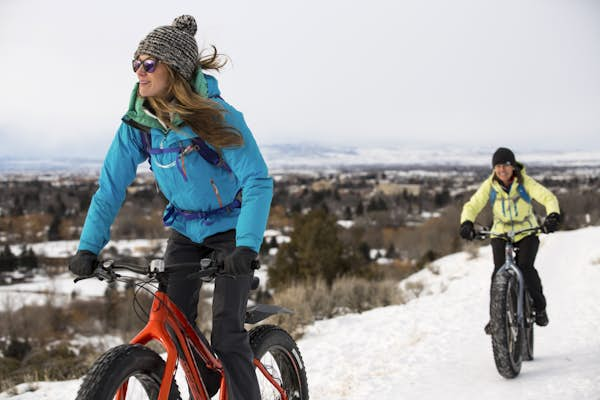
The 7 best biking trails in and around Bozeman, Montana
Bozeman is renowned as one of the most liveable cities in the US, and a big part of that is its rugged beauty and how accessible it is to the community.
The city has incredible biking trails, from single-track adventures in the wilderness to leisurely pathways through urban parks that are perfect for kids and those new to exploring on two wheels. There’s even an active cycling community ready to offer a helping hand or words of advice when needed.
We’d highly recommend a mountain bike for those who like to venture into the wilderness and go off-road. It opens up endless miles of grand mountains and forests around Bozeman, and you’ll be able to cover much more ground than hiking would allow.
Numerous paved routes and urban tracks mean you can cycle in Bozeman regardless of the season or weather. Some hill trails are open year-round, and many ski resorts offer fat tire biking during the winter season, as well as fully-charged downhill rides in summer. These are our favorite trails to explore, and some top tips to ensure your biking trip to Bozeman is one to remember.
Tips for biking in Bozeman
- Bozeman’s gear shops normally offer a good range of bike rentals, but check availability in advance with stores such as Bangtail Bikes and Owenhouse Cycling.
- Grizzly bears pose a particular risk to mountain bikers because cyclists move at speed and don’t make much sound to scare bears away. If you’re biking the more remote parts of the Gallatin Range, be sure to have bear spray accessible (ideally attached to your bike frame) and consider attaching bear bells to your bike.
- Tap into the local biking community in Bozeman before you hit the trails. Gallatin Valley Bicycle Club posts weekly rides, Alter Cycles has Friday drinks and weekly rides, and Bangtail Bikes organizes a Monday night ride.
- Many biking trails are shared with hikers, horse riders and even motorcyclists, so watch out for other traffic, especially on fast downhills. Some trails restrict mountain bikers to cycling on certain days, and e-bikes are considered to be motorbikes when it comes to trail-sharing regulations.

1. Bangtail Divide
Best for fit mountain bikers seeking fabulous views
25 miles, 5–6 hours, intermediate, 3100ft elevation gain
Bozeman’s single best day ride is this IMBA Epic Trail, starting in Bridger Canyon, 20 miles northeast of Bozeman. This intermediate route will take you high into the mountains for a fabulous wilderness workout and lots of downhill fun. The opening seven-mile stretch is a lung-busting uphill switchback in first gear, but the flowing single track then takes you on a classic ridgeline ride through meadows of scented wildflowers with head-spinning views of six mountain ranges.
The final section is a fabulous, swooping six-mile descent on Grassy Mountain. You then face a seven-mile road pedal back to your car, or you can be smart and arrange a shuttle pick-up. Pack plenty of water and lunch for this long day.
2. Main St to the Mountains
Best for families looking for a downtown park ride
2.5 miles round trip, one hour, easy
For an hour or two of active fun in the center of Bozeman, families can opt for an easy off-road bicycle ride on trails of packed earth and gravel running south from Main St and finishing up with ridge-top views over the city and Bozeman Creek.
Take the Gallagator Linear/Burke Park Trail from Bozeman Library through Lindley Park to Sculpture Park, before gently climbing uphill through Burke Park and then go south along the Bozeman Trail. The full return ride is around 2.5 miles, but you can turn back whenever you need to; several benches offer a chance for a breather.
Alternatively, follow the Gallagator Trail to Langohr Park (with its climbing boulder) and roll on to the Museum of the Rockies, adding on a visit to Bozeman’s best family attraction.

3. Mystic Lake
Best for mountain bikers looking for an easy ride
20 miles round trip, three hours, intermediate, 450m of elevation gain
The Sourdough Canyon Trail along Bozeman Creek to Mystic Lake is a no-stress, technically easy mountain bike route on wide and well-graded Forest Service dirt roads, passing rushing streams in the pine-scented forests of the Gallatin foothills.
The turn-around point is picnic-worthy Mystic Lake, where a Forest Service cabin offers a possible overnight adventure. The return is all downhill, back the way you came, or you can take an alternative route back along the exposed “Wall of Death” – as the name suggests, this is for confident riders only!
4. Big Sky Biking
Best for lift-served mountain bike trails and adrenaline-fuelled descents
Distances and times vary, easy to advanced
During the Montana summer, from early June to mid-September, the downhill action at Big Sky Resort shifts from skiing to mountain biking. Three lifts offer access to 40 miles of trails, covering a range of difficulties and styles, from extreme jumps to mellow banked rides. Lift passes start at $51 per day.
Beginners can start with the two-mile Easy Rider trail accessed via the Explorer Lift, or pick up some new skills on one of the weekly bike clinics. There are also good cross-country trails in the surrounding valleys, and you can go fat tire biking in winter. Try Christy Sports for rentals and trail information.

5. Spring cycling in Hyalite Canyon or Yellowstone National Park
Best for traffic-free road cycling
15.5 miles round trip, three hours, easy
Springtime in Montana brings some uncertain weather and muddy conditions on unpaved trails, but also two dream road rides. From April through to mid-May, scenic Hyalite Canyon Road to the southeast of Bozeman is open to cyclists only, snow and ice conditions permitting. It’s a real treat to be able to savor the scenic paved road that runs along Hyalite Creek up to Hyalite Reservoir without the need to keep alert for speeding traffic.
Further south in Yellowstone National Park, the spring thaw also brings a welcome period of motor vehicle-free access to the park’s western and north-western roads, linking Mammoth Hot Springs, Madison Junction and West Yellowstone. You can cycle as far as you want in sublime solitude, with road traffic limited to the occasional bison (give them a wide berth). Electric bikes are allowed in Yellowstone National Park but not on Hyalite Canyon Road.
6. Crosscut Mountain
Best for beginner mountain bikers and teenagers
Distances and times vary, easy to moderate
Crosscut Mountain to the north of Bozeman is a great place for beginners and kids. There are 14 miles of trails (including 10 miles of single track), with plenty of space to practice your skills as a family. The nonprofit organization Crosscut also runs mountain bike clinics and weeklong afternoon camps for tweens (grades 4 to 8) and teenagers. In winter, come here for some fat biking on groomed snow.

7. Leverich Canyon
Best for anyone seeking a downhill workout close to Bozeman
5 miles round trip, 1-2 hours, intermediate, 1250ft ascent
Located just past Bozeman’s southern suburbs, the Leverich Canyon loop trail kicks off with a three-mile, 1250ft ascent up the eastern side of the canyon, past an abandoned mine, before finally rewarding you with an exciting downhill, bermed single-track ride. There are several places where you can catch some air, but this is a mixed-use trail through the forest, so look out for hikers as you descend.
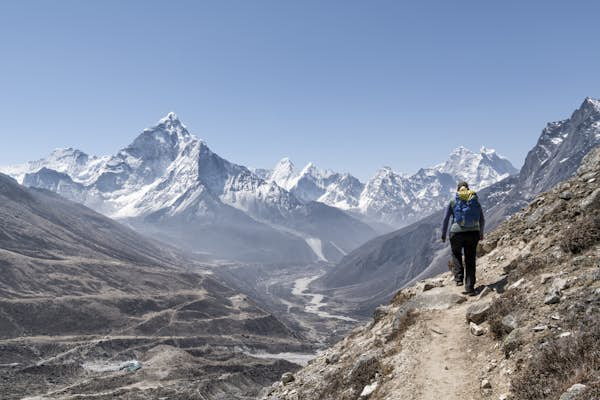
How to trek to Everest Base Camp
Few experiences are as humbling as standing at the foot of the world’s tallest mountain. On the border between Tibet and Nepal, Mt Everest – known as Sagarmatha in Nepali and Chomolongma (or Qomolangma) in the Sherpa or Tibetan language – tops out at nearly 9km (5.5 miles). After trekking for at least a week to reach Everest Base Camp (EBC), with the prospect of more hiking days still ahead as you descend, the sight of this mighty mountain surrounded by its high-altitude friends is as emotional as it is beautiful.
While this trek takes a lot of effort, some expense, and a solid two-week time commitment, the combination of Tibetan-influenced Sherpa culture, good trekking infrastructure and mountain scenery grander than anywhere else on earth makes this an unmissable trail. Whether you’re a first-timer to Nepal narrowing down your shortlist of possible trekking routes or a repeat visitor yet to make the pilgrimage to Base Camp, you won’t be disappointed.
Here’s what you need to know about trekking to Everest Base Camp in Nepal.

Why trek to Everest Base Camp in Nepal?
Mt Everest straddles the Nepal-Tibet border, but when people talk about trekking to Everest Base Camp, they almost always mean the route in Nepal. As well as having excellent infrastructure for trekkers, Nepal is more open and accessible to tourists, and from this side, the only way to reach Base Camp is on foot (or by helicopter, if you’re short on time but flush with funds). A nicely paved road leads most of the way to the mountain on the Tibetan side.
While the unobstructed views of Everest are arguably better from the Tibetan side (take it from someone who’s seen both) there’s more to this trek than just the views of the mother mountain. You’ll enjoy an unforgettable cultural experience alongside the physical challenge of one of the world’s best trekking trails. If you’re a physically active, outdoors-loving, adventurous traveler, this trek ticks all the boxes!

How long does the Everest Base Camp trek take?
The most commonly trekked route starts in Lukla, a mountain village with a tiny airstrip served by regular turboprop flights from Kathmandu. The trail meanders through Sagarmatha National Park – Nepal’s highest national park – climbing steadily to EBC before returning to Lukla. It’s an in-and-out route, rather than a circuit, and the trek typically takes 12 to 14 days. Here’s the most popular itinerary.
- Day 1: Fly from Kathmandu (1400m/4593ft) to Lukla (2860m/9383ft), then hike to Phakding (2610m/8562ft)
- Day 2: Hike to Namche Bazaar (3440m/11,286 feet)
- Day 3: Acclimatization day at Namche Bazaar
- Day 4: Hike to Dingboche (4410m/14,468ft)
- Day 5: Hike to Tengboche (3860m/12,664ft)
- Day 6: Acclimatization day at Tengboche
- Day 7: Hike to Lobuche (4940m/16,207ft)
- Day 8: Hike to EBC (5364m/17,598ft)
- Day 9: Begin the return trek by hiking to Tengboche
- Day 10: Hike to Namche Bazaar
- Day 11: Hike to Lukla
- Day 12: Return by plane from Lukla to Kathmandu

Completing the route more quickly is not recommended because of the increase in altitude. However, there are many ways to extend the trek for an extra challenge or to get away from the crowds. Here are a few options, but if you’re seeking off-the-beaten-path adventures, many trekking companies can tailor a bespoke route to suit your needs.
- Kala Patthar: Add an extra day by climbing to this viewpoint at 5644m/18,519ft before you begin the return trek to Lukla. The 360-degree views of Everest, Lhotse, Nuptse, Makalu and Cho Oyu are sensational!
- Gokyo: You can detour west from EBC to the turquoise-colored Gokyo Lakes, some of the highest freshwater lakes in the world. Returning to Lukla via the village of Gokyo will add about three days to the trek and you can summit Gokyo Ri (5357m/17,575ft) for epic views.
- Pioneer’s Route: You can skip the nail-biting flight to Lukla on the old Pioneers’ Route, which climbs from Bhandar or Salleri (accessible by bus or 4WD from Kathmandu) to Lukla over six days. This was the route that early mountaineers, including Sir Edmund Hillary, took before the Lukla airstrip was built in the 1960s.
- Tumlingtar to EBC: For a quieter trek, follow the ancient trail through Makalu Barun National Park, joining the main EBC route at Lukla after about 10 days of walking. This challenging route to EBC takes about 22 days in total, starting with a flight from Kathmandu to Tumlingtar.
- Three Passes: Make a circuit of the Sagarmatha National Park on the stunning Three Passes Trek – a very challenging route for experienced hikers that crosses three of the Everest region’s highest passes over about 20 days, starting on the main EBC trail.

What to expect on the trek
If this is your first trek in Nepal, EBC is a great route to start with as the infrastructure is good and the views can’t be beaten, but it’s not entirely typical of Nepal’s trekking routes – many trails are much more rugged, with simpler accommodation, more basic food, more challenging paths, and far fewer travelers. If you’ve trekked elsewhere in Nepal, you may be surprised by how busy the EBC route is – those photos of human traffic jams on Everest were taken at bottlenecks on the mountaineering route to the summit, but even lower down the mountain, there are plenty of people around.
Expect to spend three to eight hours per day walking along well-maintained trails, though the number of hours walked each day typically decreases as you ascend. You’ll pass through forests, trace the path of the tumbling Dudh Kosi River, and cross some dizzying swing bridges, before reaching the horseshoe-shaped hill town of Namche Bazaar – the largest settlement in Solukhumbu, the local name for the Everest region.
After Namche, the landscape becomes rockier, and the mountain peaks feel much closer. Along the way, you’ll pass Buddhist monasteries such as Tengboche, stupas, prayer wheels, and walls of ceremonial mani stones bearing Tibetan inscriptions, as well as the school founded by Sir Edmund Hillary at Khumjung, and a small museum where you can see what some locals believe is a “real” yeti skull.
The trail boasts a wide range of accommodations, especially on the first few days of the trek. As well as budget-friendly teahouses (simple lodges with restaurants offering rooms with shared bathrooms), there are some luxury lodges with artful decor and gourmet meals. Mountain Lodges of Nepal and Everest Summit Lodges offer high-quality accommodation at matching prices.
While more upmarket lodges have reasonable bathroom facilities, don’t expect long, hot showers every morning. Your daily washing routine is more likely to involve a bucket of warmed water (if you’re lucky!) and a washcloth. While walking the trails, toilets are limited; use facilities at lunch or tea stops. Facilities range from rare Western-style sit-down toilets to Asian-style squat toilets and literal holes in the ground. Keep your toilet paper and soap on hand, and be mindful of limited water supplies.

Is the Everest Base Camp trek hard?
The two-week trek to EBC requires stamina but not superhuman powers. Many older kids manage it, for example, but you’ll find it easier if you’re reasonably fit and have some experience of multi-day mountain trekking. If you’ve never hiked in your life, you may struggle, but if you have a regular workout routine of some kind, you’ll probably do fine. Pre-trek gym-based or outdoor training is a good idea.
Lukla – the most common starting point for the trek – sits at 2860m (9383ft), and you’ll climb to 5364m (17,598ft) at base camp, The trek gets harder the higher you go because the air gets thinner and the temperatures colder, especially at night. The trail is steep in places, and some of the earlier days are relentlessly uphill, such as the climb from Phakding to Namche Bazaar at 3440m (11,286ft) on day two of the hike.
- Day 1: Fly from Kathmandu (1400m/4593ft) to Lukla (2860m/9383ft), then hike to Phakding (2610m/8562ft)
- Day 2: Hike to Namche Bazaar (3440m/11,286 feet)
- Day 3: Acclimatization day at Namche Bazaar
- Day 4: Hike to Dingboche (4410m/14,468ft)
- Day 5: Hike to Tengboche (3860m/12,664ft)
- Day 6: Acclimatization day at Tengboche
- Day 7: Hike to Lobuche (4940m/16,207ft)
- Day 8: Hike to EBC (5364m/17,598ft)
Acute Mountain Sickness (AMS) is a risk on any trek above 2500m (8202ft). To give your body time to adjust, acclimatization days are essential, and guides will build these stops into the schedule. Some people start to feel the effects of altitude above 3000m (9800ft), and by 4000m (13,100ft), almost everyone will have an elevated heart rate, faster breathing, and maybe a headache and difficulty sleeping.
Some people adjust quickly to altitude, but others don’t. While everybody responds to altitude differently and there’s no guarantee a fit traveler will withstand altitude better than their out-of-shape friend, the overall experience tends to be easier if you’re fit and healthy.
Medications such as Diamox (Acetazolamide) are available in Kathmandu (or at home) to help reduce mild symptoms as you adjust to the altitude, but it’s important to be alert for more serious warning signs of AMS. If you feel unwell, descend immediately to a lower elevation – mountain sickness can be deadly.

Best Time to Trek to Everest Base Camp
The peak seasons for trekking in Nepal are from October to November, and March to May. These are the busiest times to trek to Everest Base Camp but also the best times to go for fine weather. The season for mountaineering ascents of Everest is the spring – while climbing and trekking are not the same thing, the trails will be more crowded at this time as mountaineering groups also trek to EBC.
During the monsoon season from June to September, trails can be slippery, visibility poor, and flights into and out of Lukla are often delayed or canceled. Winter (December–February) is not necessarily a bad time to trek, but you’ll need to be well-prepared for the cold. Not all tour operators offer treks in winter and many businesses on the trail close, but those who hit the trails can enjoy an uncrowded experience.
Practicalities for the trek to Everest Base Camp
As of April 2023, foreign trekkers in Nepal must be accompanied by a guide on routes through the Everest region. This increases the cost, as prices vary depending on group size, quality of accommodation and the season, but it simplifies planning.
You can join a group trek arranged through a trekking agency, or trek independently with a Nepali guide. Some top Nepali-run tour companies include Kathmandu-based Royal Mountain Travel, social enterprise Beyond the Clouds Travel and private tour specialist LaMa Walks. Solo women may like to trek with a female guide – 3Sisters Adventure Trekking trains and employs Nepali women as guides.
Prices for guided treks typically include return flights between Kathmandu and Lukla, trekking permits and national park fees, hotel or teahouse accommodation, and porters (and sometimes pack animals). Cheaper tours may require you to pay for some things as you go – for example, food at teahouses – so these trips don’t always work out cheaper than all-inclusive tours. Food costs are high in the Everest region compared to Nepal’s cities, as almost everything needs to be carried in by porters.
Permits and paperwork
As well as arranging a guide, trekkers need to register for a Trekkers’ Information Management System (TIMS) card, administered by the Trekking Agencies’ Association of Nepal (TAAN). You’ll also need to pay the entry fees for Sagarmatha National Park. Both can be arranged at the Tourist Service Center at Bhrikutimandap in Kathmandu. Nowadays, most guided tour companies take care of all your paperwork for trekking in Nepal.

An Everest Base Camp packing list
When packing for your trek, consider whether you’ll be trekking with a porter, as there are often restrictions on how much weight they will carry. This is different from a guide, who will show you the way but won’t carry your stuff. Also consider the quality of accommodation, as this will affect what you need to carry to stay warm overnight. If you leave home without something, you should be able to pick it up in Thamel (Kathmandu’s main tourist district) before you start your trek.
Trekking poles should be considered an essential piece of kit, and they can be bought inexpensively in Kathmandu. It’s easy to spot first-time trekkers in Nepal as they’re usually the ones without poles; second-timers don’t make that mistake! Here’s a basic list of other things to pack:
- Sleeping bag/bag liner (but check what is included on any organized trek)
- Lightweight down jacket (or equivalent)
- Waterproof jacket or a poncho
- Merino wool or polypropylene base layers
- Hiking boots – already broken in, not purchased in Kathmandu – and hiking socks
- Clothing to wear overnight, such as a tracksuit
- Quick-drying underwear that you can handwash on acclimatization days
- A warm hat and a sunhat
- Sunglasses
- Personal medications and first-aid items (guides normally carry the basics)
- Sunscreen
- Hand sanitizer and biodegradable wet wipes
- Bar or liquid soap
- Toothpaste and a toothbrush
- Toilet rolls or tissue packets
- Nail clippers and blister treatment, such as sticking plasters and antiseptic ointment




